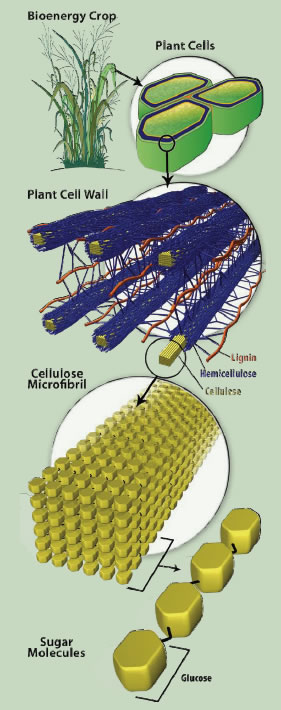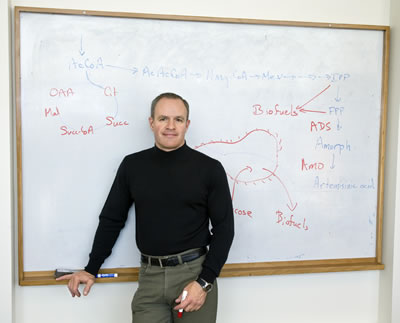The Evolutionary Road to Biofuels
By Lynn Yarris
The story is told that in the summer of 1859, Whitwell Elwin, editor of the prestigious British journal, Quarterly Review, was sent an advanced copy of a book by the naturalist Charles Darwin entitled: On the Origin of Species. While intrigued by the idea that organisms evolve over generations through a process of natural selection, Elwin thought the subject matter too arcane to sell many books. His advice to Darwin: “Write about pigeons. Everyone is interested in pigeons!”

Lignocellulose, the most abundant organic substance on Earth, is composed of three major constituents - cellulose, hemicellulose and lignin that combine to protect energy-storing sugars and give the plant cell wall strength and structure.
To the good fortune of us all, Darwin ignored this advice and his book, published in November of that year, has never been out of print. It was Darwin’s contention that life is a fiercely competitive dance-to-the-death in which organisms pass advantageous genetic traits on to future generations to ensure their survival. Through this process, for example, plants have evolved a tough defensive armor, called “lignocellulose,” to protect the valuable solar-energy storing sugars housed within their cell walls from attacks by insects and microbes. That same process, however, has pushed microbes and insects into evolving enzymes that act to break down lignocellulose. This particular evolutionary dance is now playing a critical role in the drive to develop advanced biofuels that can replace gasoline on a gallon-for-gallon basis and can be burned without exacerbating the threat of global warming.
Berkeley Lab is the leader of a partnership called the Joint BioEnergy Institute (JBEI) whose mission is to achieve the scientific breakthroughs that will make possible commercial-scale production of advanced biofuels that can meet a substantial portion of our nation’s transportation energy needs. Currently, gasoline accounts for about 60-percent of petroleum consumption in the United States and generates about 25-percent of our greenhouse gas emissions. Tapping into the vast reserves of solar energy stored within the sugars in plant cell walls would not only reduce these greenhouse gas emissions, but would also lessen our dependency on petroleum imports. Evolution holds the key to both the challenge and the success of this endeavor.
Lignocellulose, the most abundant organic substance on the planet, is composed of three major constituents - cellulose, hemicellulose and lignin. Cellulose consists of tightly bound sugar chains organized into strong cable-like microfibrils that harbor thousands of glucose molecules. Glucose is a simple sugar that can be readily fermented into biofuel if it can be accessed. Hemicellulose is made from a variety of five- and six-carbon sugars that are difficult to ferment into biofuels. Lignin is a rigid non-carbohydrate polymer that forms a protective coating around cellulose and hemicellulose. It is also a source of chemical by-products that can inhibit the conversion of sugars into biofuels.
“There is enough idle biomass that could be converted into a large fraction of our transportation fuel needs if we can learn to efficiently extract all plant sugars and convert them into liquid fuels,” says Jay Keasling, the CEO of JBEI and a chemical engineer who holds joint appointments with Berkeley Lab and University of California (UC) Berkeley, He is also one of the world’s leading authorities on biofuels. “To accomplish this, we need to engineer lignocellulose to make it easier for microbes to deconstruct it into fermentable sugars, and we need to engineer microbes to improve their ability to convert those sugars into biofuels.”
Towards this end, one group of JBEI researchers are developing “pretreatments” of lignocellulose to enhance its deconstruction into fermentable sugars. This involves the developing ionic liquids (molten salts) that can dissolve lignin off of sugars, or finding exotic new enzymes that can deconstruct both sugars and lignin. The search for new enzymes is taking them into uncharted microbial territories, such as rain forest floors and composts. The microbial communities inhabiting such environments have evolved very different enzymes for lignocellulose deconstruction from the enzymes used in the conventional production of ethanol.
Explains Keasling, “When you walk through a rain forest, you aren’t constantly climbing over fallen trees and other debris because microbes there have evolved enzymes that can deconstruct this material into nutrients.”
When effective new enzymes have been identified, they will be studied at the molecular level. JBEI scientists will then employ the latest genetic technologies, including synthetic biology and directed evolution, to design and engineer enzymes that are even better.

Jay Keasling, a chemical engineer, serves as Chief Executive Office for JBEI, holds major appointments with Berkeley Lab and UC Berkeley, and is one of the world’s foremost authorities on synthetic biology and biofuels.
A second JBEI group is working on the creation of new sugar-fermenting microbes that are capable of fermenting complex sugars, unlike the common yeast which can only ferment simple sugars. They are looking at special strains of E. coli and yeast that have already been genetically engineered to produce ethanol from complex sugars as model systems. Eventually they also plan to look at the genetics and metabolic pathways of Sulfolobus solfartaricus, an extremophile that is able to survive and thrive under conditions even more stressful than biofuel production.
“Plants have evolved over eons to resist biological and chemical assaults, but microbes and insects have evolved enzymes to counteract this resistance,” says Keasling. “We can learn from what natural evolution has given us, but we don’t have to merely accept it. Through such tools as synthetic biology and directed evolution we can try to do better.”
JBEI is one of the BioEnergy Research Centers sponsored by the U.S. Department of Energy. JBEI partners, in addition to Berkeley Lab, are the Sandia National Laboratories, the UC campuses of Berkeley and Davis, the Carnegie Institution for Science and the Lawrence Livermore National Laboratory.
Additional Information
- For more information about the Joint BioEnergy Institute, visit the Website at www.jbei.org
- For more on the national celebration of the Year of Science go here.


